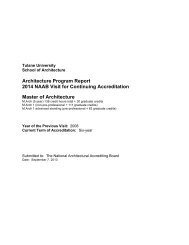Architecture Program Report Tulane University New Orleans ...
Architecture Program Report Tulane University New Orleans ...
Architecture Program Report Tulane University New Orleans ...
You also want an ePaper? Increase the reach of your titles
YUMPU automatically turns print PDFs into web optimized ePapers that Google loves.
highest level.<br />
In the United States, there are a dozen or so programs of excellence in architecture.<br />
This is a relatively small number given that there are approximately 125 accredited<br />
educational programs nationwide. Having consistently received accolades in several<br />
respected surveys of architectural education, these programs, mostly at the graduate<br />
level and almost all arrayed on either the East or West coasts, are perceived to be<br />
exceptional architectural programs for several reasons, They benefit, almost without<br />
exception, from large endowments, significant alumni involvement, adequate staffing<br />
and administration, high student and faculty quality, location, exceptional facilities, and<br />
high levels of the most advanced digital, media and materials technologies. In addition,<br />
one of the most prominent reasons for having achieved a reputation as a program of<br />
excellence is that they house a program or programs of distinction—areas of<br />
specialization that act as harbingers of change and development for not only<br />
architectural education, but the architectural profession as well.<br />
In the spring and summer of 2005, the <strong>Tulane</strong> School of <strong>Architecture</strong> undertook to<br />
develop a list of both aspirant and peer group programs of architecture. While initially<br />
faculty generated during a formal Strategic Planning Initiative session, this aspect of<br />
strategic planning research is an ongoing charge of the School of <strong>Architecture</strong>'s<br />
Curriculum Committee.<br />
The aspirant programs are indeed programs of excellence (some rank high on the list in<br />
several surveys) that reflect in several ways <strong>Tulane</strong>'s educational program, whether in<br />
size, student and faculty quality, type of location and facilities, administrative structure,<br />
and/or alumni participation. These programs are known as programs of distinction<br />
because of their high degree of visibility, and because their students, according to the<br />
Design Professions Survey among others, are perceived to be exceptionally wellprepared<br />
for the rigorous pursuit of architectural practice at entry level positions. Many<br />
of these programs are part of the Benchmark Analysis appendix at the end of this<br />
document.<br />
Peer group programs of architecture include those that <strong>Tulane</strong> School of <strong>Architecture</strong> is<br />
directly competitive with for students and faculty of quality. They are also understood,<br />
with some exception given to financial resources, as similar in type of program<br />
(undergraduate), size, kinds of programs, special events and physical facilities. In<br />
addition, they stand near or at the same level as <strong>Tulane</strong>'s program in surveys of likely<br />
matriculation. Included in this group are programs and schools of architecture located at<br />
Cornell <strong>University</strong>, Rice <strong>University</strong>, Washington <strong>University</strong> in St. Louis, Syracuse<br />
<strong>University</strong>, <strong>University</strong> of Virginia, Miami <strong>University</strong>, <strong>University</strong> of Texas at Austin, Notre<br />
Dame, and Carnegie-Mellon <strong>University</strong>. These programs are also included in the<br />
Benchmark Analysis appendix at the end of this document.<br />
5. SWOT Analysis<br />
The School of <strong>Architecture</strong> underwent review by the National Architectural Accrediting<br />
Board (NAAB) in 1999 and 2002. The accreditation process is comprised of an<br />
Architectural <strong>Program</strong> <strong>Report</strong> (APR), prepared by the School, followed by a site visit with<br />
a team comprised of members of the five collateral organizations governing architectural<br />
in the United States. These five organizations are: the National Architectural Accrediting<br />
Board (NAAB), the American Institute of Architects (AIA), the American Institute of<br />
Architectural Students (AIAS), the Association of Collegiate Schools of <strong>Architecture</strong><br />
(AIAS), and the National Council of Architectural Registration Boards (NCARB). In<br />
aggregate, these groups represent diverse architectural constituencies.














